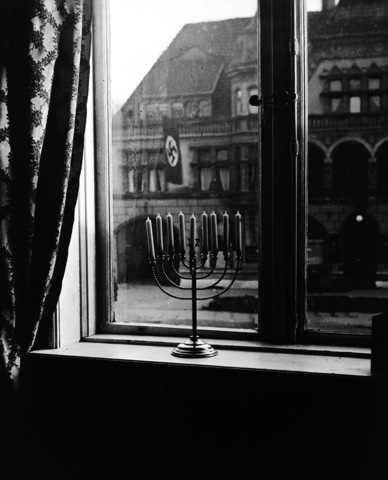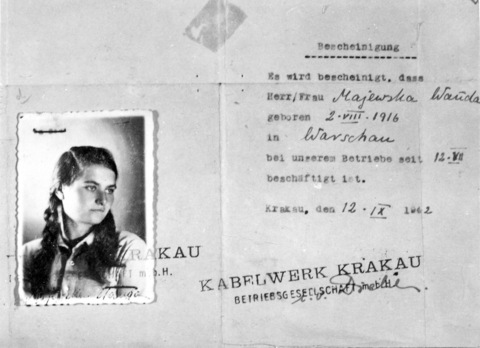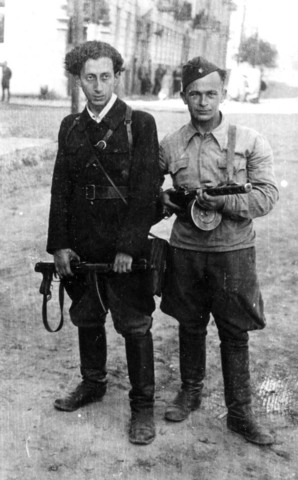The discipline and determination are half-brilliant, half-mad: In 1940, in Warsaw, the Polish-Jewish historian Emanuel Ringelblum decided that the entire experience of Jewry under Nazi rule should be thoroughly documented. The internment of Jews within the Warsaw ghetto, he wrote (with chilly irony), "provided even greater opportunity for development of the archive."
A competition was established to select writers, teachers and intellectuals; they would study topics like community life, education, crime, youth, art and religion, while helping to smuggle information into the ghetto. Comprehensiveness and objectivity were meant to eclipse surrounding horrors, documenting them for the future. The secret project was called, in heavily sardonic code, Oyneg Shabbes, using the Yiddish words for a celebration welcoming the Sabbath.
"To our great regret, however, only part of the plan was carried out," Ringelblum writes, explaining with hyperbolic understatement: "We lacked the necessary tranquility for a plan of such scope and volume." Writers were executed; some were exiled for slave labor; and, in 1942, hundreds of thousands of ghetto residents were deported to death camps. Before the ghetto was consumed in the final conflagrations of an armed rebellion, Ringelblum's archive was buried in tin boxes and milk cans that were only partly rediscovered after the war.

This epic is briefly alluded to in the exhibition Daring to Resist: Jewish Defiance in the Holocaust, opening Monday at the Museum of Jewish Heritage in association with the Ghetto Fighters' House in Israel. Ringelblum is mentioned here, and facsimiles of the buried documents (now housed in Warsaw) are shown, but they are primarily demonstrating that in extreme times resistance to tyranny takes many forms. One is the enterprise of Oyneg Shabbes: documentation.
Other forms of resistance are reflected in objects that in ordinary times have no distinctiveness: a ritual slaughterer's knife used at great risk to butcher kosher chickens in Denmark so they could be smuggled into Germany in the 1930s; a blue-and-white wrestling sash from 1934 awarded to Jewish contestants no longer permitted to compete with their fellow Germans; a girl's 1938 report card from a school founded by Jews in Berlin after Jewish children were banned from public schools.
And reflecting later years are artifacts from even darker times, including false documents used by Jewish women who were couriers secretly bearing information from beyond the walls of ghettos and camps.

Also on view are a violin, a stage set, school notebooks: all relics of a resilient Jewish life nurtured at the brink of extinction. ("When the children will come out of the cage," one survivor recalls being told, "they should be able to fly.")
There is even a pillowcase given to a Lithuanian woman by Rivka Gotz, who defied the Nazi ban on Jewish childbirth and smuggled her newborn son, Ben, out of the Shavli ghetto in a suitcase, placing him under the woman's secret care. The pillowcase now comes from Ben Gotz's collection.
Such is the evidence of resistance of one kind or another: creating institutions in the face of oppression; following religious observances that were the object of Nazi repugnance; continuing cultural life with defiant pride; risking life to bring new life into being. It is not until late in the exhibition that visitors see the first guns used by Jewish partisans or can read the first accounts of their sabotage as they darted from forests like gnats in the face of the German war machine.

PHOTOS: NY TIMES NEWS SERVICE
The exhibition's curator, Yitzchak Mais, former director of the Yad Vashem museum in Jerusalem and a curator of the planned Illinois Holocaust Museum in Skokie, explains in a valuable companion volume to the show (which also includes many difficult-to-find firsthand accounts) that his intention was to address the kinds of accusatory questions that the writer Primo Levi said he often heard as a survivor: "Why did you not escape? Why did you not rebel?"
Mais' answer is that Jews did, again and again. There were more than 90 Jewish fighting organizations in European ghettos and three rebellions at the hellish centers of the Nazi death-kingdom: at Sobibor, Treblinka and Auschwitz-Birkenau. But also, Mais suggests, "visitors to our exhibition will be challenged to re-evaluate their understanding of what constitutes resistance."
This is the show's greatest strength, and also its greatest weakness. It is a strength because to demonstrate how all of this involved resistance, the exhibition must convey just how extraordinary the circumstances were: the gradually tightening grip that held European Jews; the impressions that couldn't fully foreshadow what was to come; the human impulse toward hope being slowly stifled. "How does one respond," an introductory film asks, "when the future is unknown?"
"Who can you turn to?" asks the label text. "Who will speak for you when your government turns enemy and neighbors turn away?" "Is it better to lie low or stand tall?" And another question: "To stay or to go?"
When the scale of the Nazi ambition starts to become clear, it is beyond comprehension. The show includes numerous fragments of interviews with survivors (which unfortunately are too brief and miscellaneous) that capture those impressions. One woman recalls the postcards arriving from relatives whom the Nazis had just relocated "East"; they are full of carefully phrased optimism and artificially cheery description. But after the Nazi-supervised pap, one card ominously adds: "Very soon we are going to visit Uncle Mavet." Mavet, in Hebrew, means death.
But the exhibition's polemical focus is also a weakness, for it ends up turning resistance into a catchall concept that applies to any refusal to submit completely. There is an element of truth here, but also a needless desire to encompass every act of pride and survival within the idea of resistance. The result is almost too reassuring: Jews, the label text tells us, "recognized that their most precious resource was hope," and, "They acted imaginatively to shield their communities from despair and promote the will to resist."
It is as if the exhibition were shying away from too much complication. Almost unmentioned, for example, are the moral quandaries faced by Jewish leaders who even at best had to weigh the communal benefits of cooperation with the communal costs of resistance. In one of the show's short videos, a survivor recalls being called before community leaders when they learn of her plan to escape. They cite the massacres that would follow. She is asked, "Who gave you the right to buy your freedom at the price of others?"
That dilemma is unexplored. That would mean examining the idea of resistance more intensively; making more distinctions, not fewer. Why, for example, did it take so much time for Jewish resistance to erupt into outright refusal and rebellion? In the show's companion book, the historian David Engel suggests that at first Jews saw the Nazi phenomenon as a recurrence of earlier traumas, as part of the cycle of Jewish historical experience. Jews, after all, had received full German citizenship only in 1871, so if they were deprived of benefits in 1933, it was more a regression than a cataclysm.
The sense of repetitive cycles was reinforced by the literal medievalism of German oppression: the ghettos, the yellow stars, the governing Jewish councils. These historical echoes, Engel suggests, made Jews less likely to see clearly what was happening and made resistance less likely.
Those who did see, like the partisan Abba Kovner, took very different actions. In 1941, at 23, he said the German goal was the "absolute, total annihilation" of the Jews. This put the entire situation in a new context. Unfortunately in this show one doesn't fully grasp how drastically interpretation shaped response; the partisans were a turning point as much as a continuation. Here, though, their acts almost become a supplement to broadly defined resistance, and the fighters lack individuality.
In a 2001 PBS documentary, Resistance: Untold Stories of Jewish Partisans, Kenneth Mandel and Daniel Polin tell the story through interviews with 11 partisans who become recognizable individuals recounting an astonishing past. Some of those same figures appear in this exhibition's videos, but they are stripped of context and speaking in snippets. We don't learn enough about them to fully understand their achievement.
This makes the exhibition less powerful than it might have been. But at a time when Nazism has become a denatured metaphor for any political system deemed unpleasantly powerful, and when the concept of resistance has been perverted into meaninglessness by terrorist groups boasting exterminationist goals, this show begins to re-establish the sense of scale that once made Nazism so horrific and resistance so difficult.

Even by the standards of Ukraine’s International Legion, which comprises volunteers from over 55 countries, Han has an unusual backstory. Born in Taichung, he grew up in Costa Rica — then one of Taiwan’s diplomatic allies — where a relative worked for the embassy. After attending an American international high school in San Jose, Costa Rica’s capital, Han — who prefers to use only his given name for OPSEC (operations security) reasons — moved to the US in his teens. He attended Penn State University before returning to Taiwan to work in the semiconductor industry in Kaohsiung, where he

On May 2, Chinese Nationalist Party (KMT) Chairman Eric Chu (朱立倫), at a meeting in support of Taipei city councilors at party headquarters, compared President William Lai (賴清德) to Hitler. Chu claimed that unlike any other democracy worldwide in history, no other leader was rooting out opposing parties like Lai and the Democratic Progressive Party (DPP). That his statements are wildly inaccurate was not the point. It was a rallying cry, not a history lesson. This was intentional to provoke the international diplomatic community into a response, which was promptly provided. Both the German and Israeli offices issued statements on Facebook

May 18 to May 24 Pastor Yang Hsu’s (楊煦) congregation was shocked upon seeing the land he chose to build his orphanage. It was surrounded by mountains on three sides, and the only way to access it was to cross a river by foot. The soil was poor due to runoff, and large rocks strewn across the plot prevented much from growing. In addition, there was no running water or electricity. But it was all Yang could afford. He and his Indigenous Atayal wife Lin Feng-ying (林鳳英) had already been caring for 24 orphans in their home, and they were in

Australia’s ABC last week published a piece on the recall campaign. The article emphasized the divisions in Taiwanese society and blamed the recall for worsening them. It quotes a supporter of the Taiwan People’s Party (TPP) as saying “I’m 43 years old, born and raised here, and I’ve never seen the country this divided in my entire life.” Apparently, as an adult, she slept through the post-election violence in 2000 and 2004 by the Chinese Nationalist Party (KMT), the veiled coup threats by the military when Chen Shui-bian (陳水扁) became president, the 2006 Red Shirt protests against him ginned up by